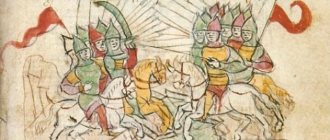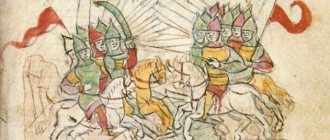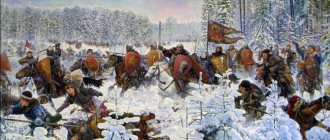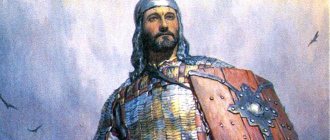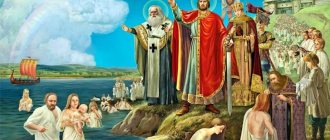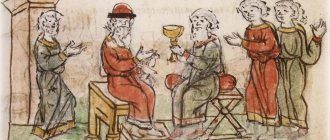short biography
Vladimir Svyatoslavich Portrait from the “Tsar's Titular Book” of the 17th century Detailed biography
Prince Vladimir I the Great is the son of Prince Svyatoslav Igorevich and Malusha, the slave-concubine of Princess Olga, under whom the Baptism of Russia took place. Also known by the nicknames “Saint”, “Baptist”, and is associated with the folklore character “Vladimir the Red Sun”. He was appointed prince of Novgorod by his father in 970. In 978 or 980 he seized the Kiev throne after the murder of his brother Yaropolk in an internecine war.
In 988, he took the Byzantine city of Chersonesus and demanded his sister from the Byzantine emperor to be his wife. As a condition of marriage, he accepted Christianity according to the Greek rite, after which he made it the state religion of Kievan Rus.
During his reign he had a large number of children from different wives, which predetermined the second civil strife in Rus' after his death in 1015.
Children
The Tale of Bygone Years conveys Vladimir’s lifestyle before baptism as follows:
“Vladimir was overcome by lust, and he had wives […], and he had 300 concubines in Vyshgorod, 300 in Belgorod and 200 in Berestovo, in the village that is now called Berestovo. And he was insatiable in fornication, bringing married women to him and corrupting girls.”
Thus, it is not possible to find out for certain how many children Vladimir I Svyatoslavich could have had.
Reign of Prince Vladimir I Svyatoslavich 980-1015
Interactive timeline
The beginning of the reign - the civil strife of the Svyatoslavichs
The beginning of the first civil strife in Rus', which arose 5 years after the death of Prince Svyatoslav Igorevich, was the murder of the son of the Kyiv governor Sveneld by Oleg Svyatoslavich during a hunt. Sveneld took advantage of his influence on the young Prince Yaropolk and decided to take revenge on his son’s murderer. Having learned about Oleg’s death during a clash with Yaropolk’s troops near the city of Ovruch, Vladimir fled “overseas” and returned the next year with a mercenary army of Varangians. Having found a traitor among Yaropolk’s advisers in the person of Voivode Blud, Vladimir cunningly lured his brother out of the besieged Roden fortress for negotiations and ordered his death, after which he occupied Kyiv and began to rule autocratically.
According to the chronicle, Vladimir reigned in Kyiv in 980. According to the earliest Life of Vladimir by the monk Jacob [1] “Memory and praise to Prince Vladimir”, 2nd half of the 11th century, this happened on June 11, 978.
Murder of Yaropolk. Hood. B. A. Chorikov. More about the feud
Brief description of domestic policy
After winning the civil strife and capturing Kyiv, Vladimir suppressed the uprisings of the Vyatichi and Radimichi tribes and tried to centralize the princely power. The “pagan” reform could not solve this issue, and in 988 the prince carried out a radical break - he carried out the baptism of Rus'. Greek culture began to penetrate the life of the Eastern Slavs - temples were built, schools were opened, and coinage began for the first time. Those dissatisfied with the prince's policies migrate in the northern and northeastern directions.
The accumulated contradictions did not allow the prince to carry out the last of the planned reforms - instead of inheriting by seniority, Vladimir wanted to appoint one of his favorite younger sons as the ruler of Kyiv, but he died and the older heirs started civil strife.
General scheme of the domestic policy of Vladimir I Svyatoslavich More about domestic policy
Parents
Father
Prince Svyatoslav Khud.
I. Varavin. (about 940 - 972 spring) The son of the Kiev prince Igor Rurikovich and Olga the Wise, Prince Svyatoslav the Brave took part in the first campaign very early - together with his mother, they defeated the Drevlyans who killed Igor and besieged their capital Iskorosten. Perhaps this was the reason for Svyatoslav’s thirst for battles and campaigns later. Almost nothing is known about the relationship between Svyatoslav and his sons. Vladimir spent the first years growing up under the supervision of his grandmother, Princess Olga - she ordered him to be separated from his mother almost immediately after birth, and his father spent more time on military campaigns than in Kyiv.
In 969, before the second campaign in Bulgaria, Vladimir’s father sent him to reign in Novgorod, and his uncle Dobrynya was the prince’s mentor.
Biography of Svyatoslav
Section about Svyatoslav
Mother
“Malusha says goodbye to Vladimir” Hood. S. Efroshkin
Malusha was a housekeeper slave for Princess Olga, and she herself came from Lyubech (therefore sometimes called Malusha Lyubechanka). When Olga found out about the connection between Malusha and Svyatoslav, she angrily exiled Malusha to the village of Budyatino, where Vladimir was born. Almost immediately after the birth of the young prince, he was taken in his grandmother to Kyiv, and no more information is given in the chronicles about the fate of Malusha. Her name appears in the description of the cause of the conflict between the Polotsk princes Rogvold and Vladimir, when Rogvold’s daughter Rogneda, while refusing Vladimir’s matchmakers, contemptuously called Vladimir “rabichich,” i.e. son of a slave. Prince Dobrynya's mentor and uncle, who was Malusha's brother, then took cruel revenge on Rogneda.
Briefly about the essence and directions of foreign policy
The goal of the foreign policy of Vladimir I Svyatoslavich was to expand the influence of Kiev in all directions: conflicts with Poland over border lands and tribes, campaigns against Volga Bulgaria and the Khazars, the fight against the Pechenegs and relations with Byzantium - the actions of the Grand Duke were directed to the borders of the state from its center, Kiev. Unlike his father, Svyatoslav Igorevich, Prince Vladimir more often used diplomacy and, when carrying out incursions into foreign lands, preferred not to send troops deep into enemy territory, as a result - the results of his foreign policy actions were more stable than those of his predecessor. In recent years, the new Polish prince Boleslav I tried to fight with Vladimir, but soon peace was concluded, supported by a dynastic marriage between the son of the Kyiv prince Svyatopolk and the daughter of Boleslav, unknown by name.
Foreign policy of Vladimir I Svyatoslavich - map with directions of campaigns More about foreign policy
Table “main events of Vladimir I’s foreign policy”
| Year/event | Result |
| 981 – Russian-Polish war | As a result of successful military operations, Vladimir captures the so-called cities. Chervonnaya Rus - Peremysh, Cherven, etc. |
| 983 - campaign against the Yatvingians | The tribe bordering Poland and Russia was defeated and was obliged to pay tribute |
| 985 - campaign against Volga Bulgaria | Together with the Torks, Vladimir defeats the Bulgar army, but on the advice of the governor Dobrynya, he decides that attempts at conquest are futile and makes peace |
| 986-987 – “Test of Faith” | After receiving ambassador-preachers from different religions, Vladimir gathered a council and, as a result, sent responsible people to the countries of ambassadors to familiarize themselves with the rituals. |
| 988 - war with Byzantium | March on the Byzantine colony of Korsun: after the successful capture of the fortress, peace was restored on the terms of the baptism of Vladimir and the marriage between him and the Byzantine princess Anna. |
| 990 – hike to Mieszko I | Vladimir defeated the troops of the Polish prince somewhere across the Vistula River, after which a profitable peace was concluded. |
| 992 – campaign against the White Croats | one of the last independent East Slavic tribes was defeated and came under the rule of Kyiv |
| 996 – Battle of the city of Vasilev | According to the chronicles, this is the only battle in which Vladimir was defeated by the Pechenegs. |
| 1006 – embassy of the Volga Bulgars | A profitable trade agreement was concluded |
| 1013 summer-autumn - Polish-Pecheneg campaign | The new Polish prince Boleslav, together with the Pechenegs, invaded Rus', but during the devastation of the territories, the allies quarreled and the Polish prince ordered the killing of the nomads |
| 1014 – Russian-Polish world | Reception of ambassadors from the Polish prince Boleslav I and the conclusion of a dynastic marriage between Svyatopolk and the Polish princess |
Last years of reign
At the final stage of his political life, the prince no longer went on campaigns himself - the command of the squad was entrusted to the governors and his beloved son Boris. In 1014, two of his sons, Svyatopolk and Yaroslav, rebelled against Vladimir: Yaroslav refused to pay the 2,000 hryvnia tax due from Novgorod, and Vladimir ordered Svyatopolk to be thrown into prison on suspicion of preparing a coup. Instead of Svyatopolk, his wife, the daughter of Boleslav I, and the Polish bishop who came with her were sent under arrest - the purpose of the previously concluded dynastic marriage was not so much to confirm peace between Russia and Poland, but to seize power from the hands of the aging Vladimir. This is quite consistent with the description of Bolaslav from the German chronicler and bishop Thietmar of Merseburg, who emphasizes the “foxy resourcefulness” of the Polish prince [2] “Chronicle of Thietmar of Merseburg.
Vladimir was going to go to war against Yaroslav, but he was already too old and could not go due to his illness. Meanwhile, news arrived from the border outposts about the approaching Pechenegs and the prince ordered his son Boris, together with the grand ducal squad, to go to intercept the nomads.
Death and aftermath
Vladimir I Svyatoslavich died on July 15, 1015, in his country residence Berestov, near Kiev. Almost immediately after the death of the prince, a second civil strife began in Rus' - his sons began to fight each other for power. First, Svyatopolk the Accursed was able to capture the Kiev table, according to the chronicle, who sent assassins to his three brothers: Boris, Gleb and Svyatoslav Drevlyansky. Then, after several years of confrontation, Yaroslav the Wise was able to expel Svyatopolk in 1019, and he himself established himself in Kyiv, but was forced to defend his power in conflicts with his nephew Vyacheslav Bryachislavich and brother Mstislav of Tmutarakan. The final peace came only in 1026.
Scheme - the second strife in Rus' Civil strife among the children of Vladimir I
Conquests
Chroniclers note the changed style of the prince's reign after his baptism. Vladimir abandoned military raids and preferred peaceful coexistence with all his neighbors with the exception of the Pechenegs, who regularly invaded Russian lands.
To protect his lands, the ruler built large cities, where the governors were his sons, whom the ruler completely trusted. The Bulgarians, Hungarians, and Finno-Ugric tribes came under Vladimir’s hand.
The last military campaign was an attempt to pacify the son of Yaroslav, who showed disobedience and rebelled. During this campaign, the prince fell ill and soon died.
Results and results of the board
- As a result of the civil strife of 977-980, Vladimir killed his brother Yaropolk and came to power.
- At the beginning of his reign, he was faced with the need to suppress the uprisings of the Vyatichi and Radimichi.
- After the clash with the Volga Bulgars, peace was concluded, embassies were exchanged, and in 1000 a profitable treaty was concluded.
- A campaign was made against the Khazars, but it was not possible to gain a foothold in the lower reaches of the Volga.
- At first he tried to focus on paganism, then he converted to Christianity and baptized Rus', which caused religious conflicts.
- For the sake of concluding the first dynastic marriage between the ruling houses of Rus' and Byzantium, Vladimir made Christianity the state religion, helped the ruler of Constantinople suppress the uprising of Bardas Phocas and carried out campaigns against the Danube Bulgarians. Having joined the ranks of the Christian states, Rus' overcame civilizational isolation, Greek culture actively began to penetrate the life of the Slavs, and the Greeks no longer expected to be afraid of the pagan Rus.
- Vladimir was able to temporarily stop the onslaught of the Pechenegs by building defensive ramparts, founding fortified cities and relocating northern tribes to guard the borders.
- The beginning of coinage in Rus' dates back to the reign of Vladimir.
- The confrontation with Poland that began during Vladimir’s lifetime was successful, but after the death of the prince, the Poles took advantage of the civil strife to return part of the lands he had conquered
- He hoped to transfer the title of Grand Duke to his son Boris, bypassing the existing tradition of inheritance by seniority, which became one of the reasons for the second internecine war in Rus'.
Acceptance of Christianity
Chronicles and legends differ in their assessment of the reasons that prompted Vladimir to accept Christianity. There is a beautiful legend according to which the prince’s eyes hurt, he was almost blind, but after receiving the sacrament of baptism, he was miraculously healed.
It is also mentioned that love for Anna of Byzantium, who did not want to marry a pagan, forced the ruler to be baptized. The historical portrait of Princess Anna is inaccurate due to the paucity of details, but she undoubtedly had a great influence on her husband, and, being a religious woman, played a significant role in the spread of Christianity.
The chronicles mention the choice that the ruler gave to his envoys. The Russians did not like Islam due to the abundance of prohibitions in everyday life; the severity and strict vows of Catholics also did not appeal to them. Judaism was rejected because the Jews did not have their own land. The Orthodox religion captivated the prince's envoys with the beauty of the churches, solemn, magnificent services, and prayer chants.
It is reliably known that the sacrament of baptism took place in Chersonesos, from where the ruler and his young wife departed for their possessions, where they began to carry out religious reforms.
Followers of the pagan faith were baptized at the behest of the ruling couple in the Dnieper, where they came en masse for the priests to perform the ceremony. Vladimir completely destroyed the old temples and cruelly punished adherents of paganism. The church became an organization influencing secular life. The prince established church tithes. From now on, artisans had to give a tenth of their income to the church. The Tithe Church was built with this money.
The baptism of Rus' was not accompanied by known large-scale riots or uprisings. The people of Kiev willingly accepted the new faith, while the Novgorodians were considered ardent adherents of traditions. The prince suppressed the discontent of the people, and within a short period of time Christianity became the dominant religion in Rus'.
What was the mother of the Baptist of Rus' like?
Let's look at the circumstances of Malushi's life.
If we draw a parallel with today, then her position would be comparable to some minor employee in a huge enterprise. What could have happened for the Grand Duke to pay attention to her? Was it only beauty that could captivate him?
Perhaps also the girl's intelligence. After all, the housekeeper was in charge of the household supplies, and this was a troublesome task. You should always keep in mind how much stock you have and where, and what is about to disappear and what is missing. The whole day passes in household chores. You can’t hide from human eyes, you have to be sociable (yes, the word is from modern times, but the quality didn’t appear now). It’s possible that the Grand Duke of Kyiv somehow took a liking to the economical girl.
Vanguard
Costume sketch. Prince Vladimir. Opera "Rogneda"
Russian antiquity also serves as a source of inspiration for avant-garde artists. They are especially interested in folk art - lubok, which is characterized by flatness and some caricature of the characters, as well as bright, almost flashy colors. In the sketch of the student of Nicholas Roerich and Ivan Bilibin, Alexandra Shchekotikhina-Pototskaya, for the 1916 production of the opera “Rogneda” (from the collection of the State Central Theater Museum named after A.A. Bakhrushin), the figure of Vladimir is depicted flatly, without black and white elaboration, and the details of the face are described deliberately simply: they are disproportionate and reminiscent of popular prints.
How does the icon of St. Vladimir help?
The noble ruler bequeathed to the Russian people to see the true Creator and acquire the Orthodox faith. He asked the Lord for help against the enemy and always hoped for victory over the enemy forces.
- In front of the icon, the faithful are asked for intercession; the believer asks that God hear the request.
- The holy prince is able to protect Russian cities if a person is sincere in his prayers.
- He also rejects obsessions from dark forces, unclean magic and sorcery. The icon of the noble prince is capable of reconciling the warring parties, bringing peace and harmony to the relationship between the two conflicting parties.
- The saint saves from the influence of heretics who are trying to split Orthodoxy.
- Prayers to the miraculous image heal from serious illnesses and repel various intrigues of enemies.
Ordinary lay people have the opportunity to say prayers not only in church, but also at home; for this it is necessary to build a personal iconostasis. In one of the corners of their own apartment, believers combine miraculous images with the faces of the Virgin Mary and Christ.
Advice! The Church also advises adding canvases with images of holy people after whom family members were named to the home iconostasis.
Prayer before the icon
Holy saint of God, wise Prince Vladimir! Do not ignore our prayers, beg the Lord for us, so that He will not be angry for our sins, committed voluntarily or involuntarily, but will be worthy of His mercy and forgiveness, so that we may be worthy of Salvation and the Kingdom of Heaven. To You, O All-Merciful One, we cry: save us from enemies visible and invisible, from the slander of the devil and man, from ailments of body and soul. Do not leave your patronage in deeds done for the good of mankind. Forever and ever we send up glory to the Father, and the Son, and the Holy Spirit. Amen.
